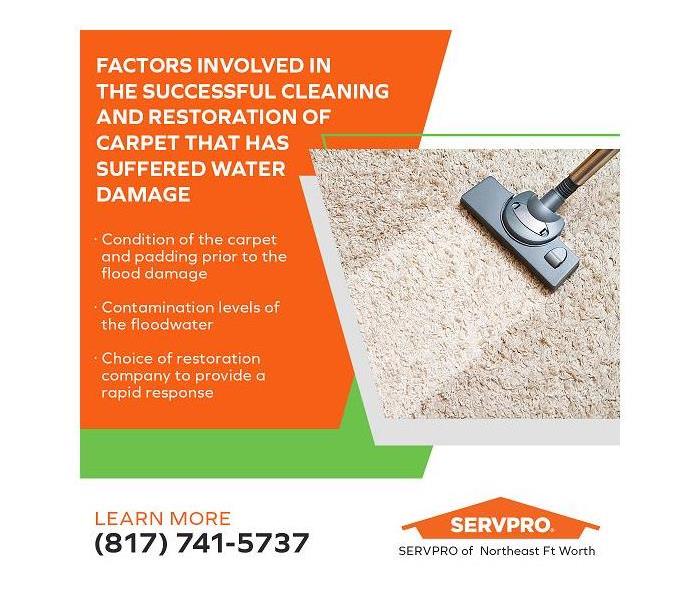What Factors Determine If Carpeting Can Be Saved during the Water Damage Restoration Process?
2/11/2022 (Permalink)
Blog Summary: When the carpet is damaged by water intrusion, several factors must be considered when determining whether carpeting needs to be restored or replaced.
The professionals at SERVPRO of Northeast Fort Worth know that water damage restoration involving water contaminated with gray water and black water presents serious health effects for technicians, occupants of the home, and pets. A rapid response is crucial to prevent advanced secondary damage that heightens the health risk. The team of highly trained and certified technicians takes every precaution as they act fast to remove the contaminated water and begin the cleaning and restoration process.
After water intrusion or flooding, damaged carpeting is often a concern, and homeowners must decide whether the carpet can be cleaned, restored, and saved. While the replacement of carpet and padding can cost thousands of dollars, restoration, where applicable, is more affordable and cost-effective.
Many factors are involved in the successful cleaning and restoration of carpet and padding that has suffered water damage from a natural disaster, a sewage backup, or a water intrusion from a burst supply line, roof leak, or HVAC condensate pan leak.
Factor #1: Condition of the carpet and padding prior to the flood damage
A key factor to consider when determining whether the flood-damaged carpet can be salvaged is the pre-flood condition of the floorcovering. Three important questions must be answered:
- What is the age of the carpet and padding?
- What is the quality of the carpet and padding?
- How were the carpet and padding installed?
The carpet and padding may have been worn out and in need of replacement before the flood damage occurred. Low-quality contractor-grade carpet and padding may not be worth restoring, especially if the product has any age and wear on it. Lastly, poor or faulty installation may create problems that hinder or prevent restoration.
Factor #2: Contamination levels of the floodwater
An accurate assessment of the contamination level of the offending floodwater is crucial in determining if cleaning and restoring the water-damaged carpet is possible. The water damage restoration industry categorizes water into three main types.
Category 1: Clean water
This category includes water from a broken pipe, supply line, or rainwater that has not been contaminated with sewage, soil, pesticides, bacteria, or chemicals. Carpet and padding soaked with Category 1 water can be restored by professionals utilizing the correct equipment, remediation procedures, and cleaning solutions. However, the carpet must not have been wet for more than one to two days. By forty-eight hours, the water that has been absorbed in the carpet and padding will begin to breed bacteria, elevating the contamination level to Category 2.
Category 2: Gray water
The concentrated contamination levels in gray water can cause health effects if the water comes into contact with the skin, eyes, mouth, or nose. Examples of Category 2 water incidents include overflow from a washing machine or dishwasher, spilled aquarium water, water from a toilet overflow with no solid fecal matter, and a sump pump failure. Padding contaminated with gray water must be replaced, but with proper drying, cleaning, and sanitization, the carpet can be salvaged. A 24 to 48-hour delay in responding to a Category 2 loss will elevate it to a Category 3 loss.
Category 3: Black water
Black water is rich in dangerous pathogens; other harmful agents in black water include raw sewage. A toilet overflow with a mixture of fecal matter and urine falls under Category 3, as does flooding from rivers and streams. Surface water from thunderstorms or the aftermath of a hurricane also creates black water. It is all but impossible to clean and sanitize a carpet suffering from Category 3 water contamination.
Homeowners are advised against venturing into a flooded basement due to the possibility of electrocution or a slip-and-fall injury. Water removal, cleanup, and sanitization are best left to professionals with the right equipment, personal protective gear, cleaning techniques, and powerful disinfecting, sanitizing, and deodorizing solutions.
Factor #3: Choice of restoration company to provide a rapid response
Quick action on the part of the homeowner to contact a reputable damage restoration company in the event of a water or flood damage disaster is the first step to a successful and cost-effective water damage remediation. The second step is the rapid response of the restoration professionals. A delay of a day or two can be catastrophic, allowing secondary damage to ruin carpeting, padding, baseboards, and subflooring.
The SERVPRO team sets the industry standard with a commitment to arriving at the client’s home in about an hour after the initial contact from the homeowner. Equipped with state-of-the-art cleaning technology and proven cleaning techniques, the SERVPRO technicians provide water damage cleanup and restoration services whether the water is Category 1 or the more dangerous Category 3, black water.
For more information about Fort Worth, TX, water damage restoration, email SERVPRO of Northeast Fort Worth at office@SERVPROnortheastftworth.com. The team of damage restoration professionals can also be reached by phone at (817) 741-5737.





 24/7 Emergency Service
24/7 Emergency Service
